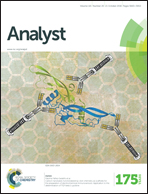Microfluidic array for simultaneous detection of DNA oxidation and DNA-adduct damage†
Abstract
Exposure to chemical pollutants and pharmaceuticals may cause health issues caused by metabolite-related toxicity. This paper reports a new microfluidic electrochemical sensor array with the ability to simultaneously detect common types of DNA damage including oxidation and nucleobase adduct formation. Sensors in the 8-electrode screen-printed carbon array were coated with thin films of metallopolymers osmium or ruthenium bipyridyl-poly(vinylpyridine) chloride (OsPVP, RuPVP) along with DNA and metabolic enzymes by layer-by-layer electrostatic assembly. After a reaction step in which test chemicals and other necessary reagents flow over the array, OsPVP selectively detects oxidized guanines on the DNA strands, and RuPVP detects DNA adduction by metabolites on nucleobases. We demonstrate array performance for test chemicals including 17β-estradiol (E2), its metabolites 4-hydroxyestradiol (4-OHE2), 2-hydroxyestradiol (2-OHE2), catechol, 2-nitrosotoluene (2-NO-T), 4-(methylnitrosamino)-1-(3-pyridyl)-1-butanone (NNK), and 2-acetylaminofluorene (2-AAF). Results revealed DNA-adduct and oxidation damage in a single run to provide a metabolic–genotoxic chemistry screen. The array measures damage directly in unhydrolyzed DNA, and is less expensive, faster, and simpler than conventional methods to detect DNA damage. The detection limit for oxidation is 672 8-oxodG per 106 bases. Each sensor requires only 22 ng of DNA, so the mass detection limit is 15 pg (∼10 pmol) 8-oxodG.

- This article is part of the themed collection: In memory of Craig Lunte

 Please wait while we load your content...
Please wait while we load your content...